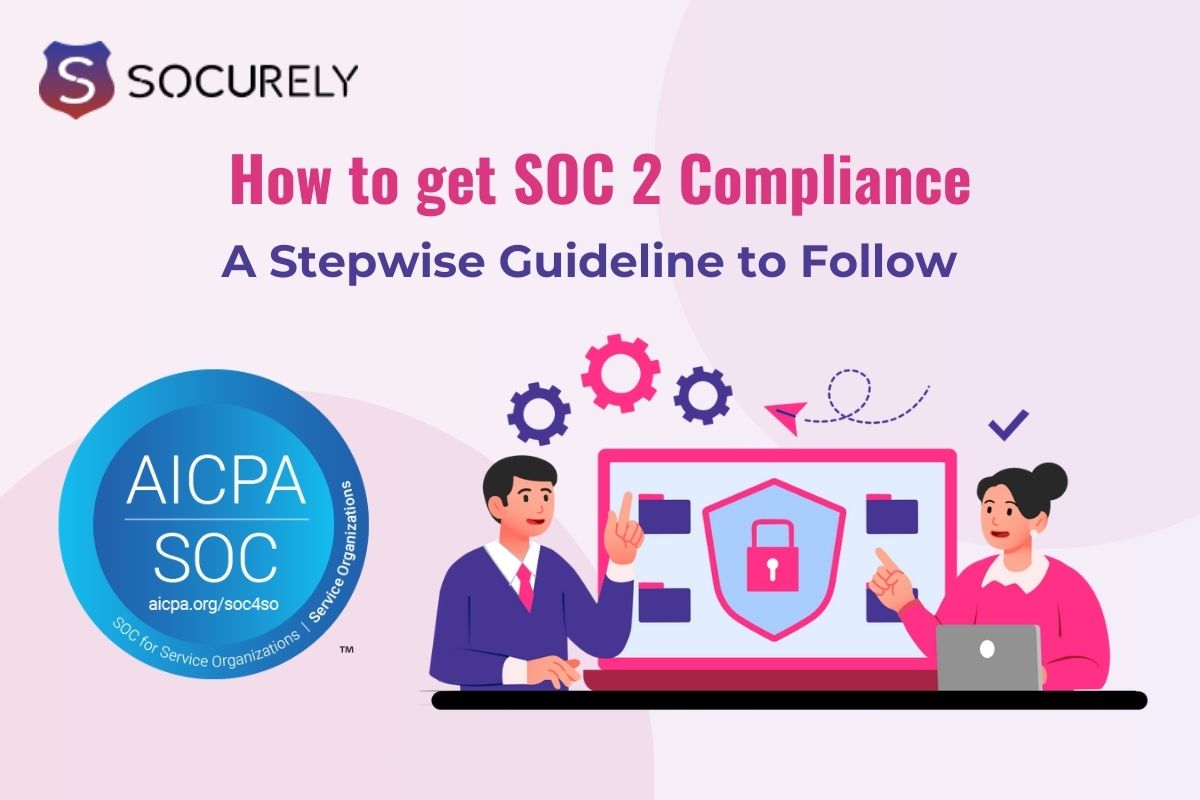Are you a start-up or mid-scale business owner looking to process client data safely without causing any blockage in your sales? If so, your business plan must need a SOC 2 Report that stands as a crucial benchmark for businesses entrusted with handling sensitive data. It not only ensures compliance with rigorous security standards but also reflects a company’s commitment to safeguarding client information. However, when you feel the need for the SOC 2 compliance requirements for your business, first it’s important to know about the process of getting this compliance.
Get to know this process along with other necessary details on SOC 2 compliance. Here we are going to discuss:
- SOC 2 Compliance Definition
- How to get SOC 2 Compliance
- Conclusion
- FAQs on SOC 2 Compliance
SOC 2 Compliance Definition
SOC 2, a badge of honor for companies handling sensitive data, ensures top-notch security. Developed by AICPA, it assesses organizations based on five trust principles: security, availability, confidentiality, processing integrity, and privacy.
This SOC 2 report process, though voluntary, is vital. It starts with selecting applicable trust principles, defining controls, and evaluating security processes. Finally, external auditors issue an attestation report.
In essence, the SOC 2 report safeguards client data from third-party service providers. It’s a streamlined process, ensuring organizations adhere to stringent data management standards for customer trust and security.
Benefits of SOC 2 Compliance for Small and Mid-scale Business
Small and large-scale businesses can benefit from SOC 2 Compliance in several ways. Know the perks await when you meet your SOC 2 Compliance requirements.
- Unparalleled privacy is ensured by encryption and two-factor authentication
- SOC 2 compliance signals to clients that your business prioritizes their data security
- Small and mid-scale businesses can outshine competitors by demonstrating robust security measures.
- It mitigates risks associated with data breaches, avoiding potential financial losses.
How to get SOC 2 Compliance: Explaining 5 Easy Steps
“How to be SOC 2 Compliant”? is indeed a big concern for small and mid-scale businesses. But worry not, here we will focus on the steps to be SOC-compliant.
Different types of SOC Compliance help small and start-up businesses in different ways. Whatever type you need, it is important to know first the proper ways to get it to meet your SOC 2 compliance requirements. Check out the key steps here.
Step 1: Selecting Trust Principles
The first step to meet your SOC 2 compliance requirements involves selecting the appropriate trust principles that align with the organization’s operations and objectives. While Security is a mandatory principle, businesses may need to consider additional principles like Privacy, Availability, Confidentiality, and Processing Integrity based on their specific data handling processes.
Understanding the nature of the business and its data ecosystem is paramount in making informed decisions about which trust principles to prioritize. This step sets the foundation for the entire SOC 2 Audit report process, laying the groundwork for subsequent control implementation and evaluation.
Step 2: Defining Controls
After your business understands the trust principles are identified, the next crucial step is defining controls to ensure compliance with SOC 2 compliance requirements. Controls serve as the mechanisms by which organizations mitigate risks and protect sensitive data from unauthorized access or misuse.
These controls encompass administrative measures, such as policies and procedures governing employee access and data handling practices, and technical security measures, including firewalls, encryption protocols, and multi-factor authentication systems.
By classifying controls into these two categories, businesses can systematically address various aspects of their security posture, ensuring comprehensive protection of client data.
Step 3: Performance Testing
The effectiveness of implemented controls is essential to verify compliance readiness to meet SOC 2 compliance requirements and identify any gaps or vulnerabilities in the security infrastructure.
While not explicitly mandated by SOC 2 standards, conducting performance tests is considered a best practice to ensure the best security measures. This readiness assessment involves systematically evaluating each control against SOC 2 requirements, identifying areas for improvement, and remedying any deficiencies.
Step 4: Audit by Certified CPA
The audit phase marks a critical milestone in the SOC 2 report process, wherein an external auditor reviews the organization’s security systems and compliance posture. During this phase, businesses are required to submit evidence demonstrating the implementation and effectiveness of controls outlined in the SOC 2 framework.
The auditor conducts a thorough assessment, verifying the organization’s adherence to SOC 2 standards and identifying any non-conformities or areas of concern. Automation of evidence collection streamlines this process, facilitating seamless collaboration between auditors and organizations and expediting the audit timeline.
The audit phase tests the credibility of the organization’s commitment to data security and validates its readiness to meet the stringent requirements of the SOC 2 audit report.
Step 5: Receiving Attestation Report
Based on the audit findings, the organization receives a SOC 2 attestation report, which serves as official documentation of its compliance with SOC 2 standards.
This report may be qualified, unqualified, or adverse, depending on the auditor’s assessment of the organization’s security posture. A qualified report may indicate minor deficiencies or areas for improvement, while an unqualified report signifies full compliance with SOC 2 requirements.
In contrast, an adverse report highlights significant shortcomings or non-conformities that warrant immediate attention and remediation. Obtaining a favorable attestation report reaffirms the organization’s commitment to data security and enhances its credibility and trustworthiness in the eyes of clients and stakeholders.
Cost Structure of SOC 2 Compliance
- Availability
- Security
- Confidentiality
- Privacy
- Processing integrity
Conclusion
The SOC 2 report process entails a comprehensive journey toward strengthening data security and fostering trust in the digital age. By meticulously following each step businesses can meet their SOC 2 compliance requirements, demonstrate their dedication to safeguarding client information, and differentiate themselves in an increasingly security-conscious marketplace.
How Socurely Can Help?
Socurely presents an innovative compliance monitoring framework that streamlines the oversight of security programs. Through our platform, businesses gain rapid, user-friendly, and intelligent tools to assess and enhance their security posture.
In a digital landscape fraught with evolving threats, Socurely stands as your trusted partner, empowering organizations to proactively safeguard their data and fortify their defenses.
Discover how Socurely revolutionizes SOC 2 compliance offering seamless and cost-effective solutions. Our intuitive dashboard provides comprehensive visibility into your compliance status, offering real-time monitoring and customizable reporting features.
We use an automation engine, and evidence collection method and go through continuous monitoring ensuring auditors receive all necessary information efficiently.
And the best part? Socurely’s pricing model reflects our commitment to affordability, leveraging automation to offer competitive rates. Ready to embark on your SOC 2 compliance journey with Socurely? Connect with our experts today to explore pricing options and completion timelines tailored to your needs.
FAQs on SOC 2 Compliance
What is the tentative time to get the SOC 2 Type 1 Report?
The SOC 2 Type 1 Report process typically spans 1 to 3 months. This timeline varies based on factors such as the complexity of the organization’s operations and the thoroughness of the audit. To meet your SOC 2 compliance requirements, be sure to keep the timeline in mind.
Is it necessary to have a certified SOC 2 report?
While the authenticated SOC 2 report isn’t mandatory, it serves as a crucial validation of an organization’s commitment to data security. Achieving SOC 2 compliance demonstrates to clients and partners that stringent measures are in place to protect sensitive information.
Who needs a SOC 2 Type 2 Report?
Businesses that provide IT services or act as third-party vendors often require SOC 2 Type 2 reports. This audit report provides a deeper level of assurance, demonstrating not only the design but also the effectiveness of controls over an extended period, typically between 3 to 12 months.
What challenges are commonly faced in obtaining SOC 2 attestation?
Several challenges may arise during the SOC 2 compliance journey, including accurately defining the audit scope, aligning business practices with framework requirements, ensuring comprehensive documentation of policies and procedures, selecting the right auditor, conducting thorough risk assessments, finding suitable pen test partners, and streamlining evidence collection processes. Overcoming these challenges requires careful planning, collaboration, and dedication to achieving and maintaining compliance.
How does SOC 2 compliance benefit my business beyond meeting regulatory requirements?
SOC 2 compliance requirements extend beyond regulations, signaling a commitment to data security. It builds trust with clients, attracts security-conscious customers, and streamlines internal processes, enhancing operational efficiency and resilience against data breaches.







